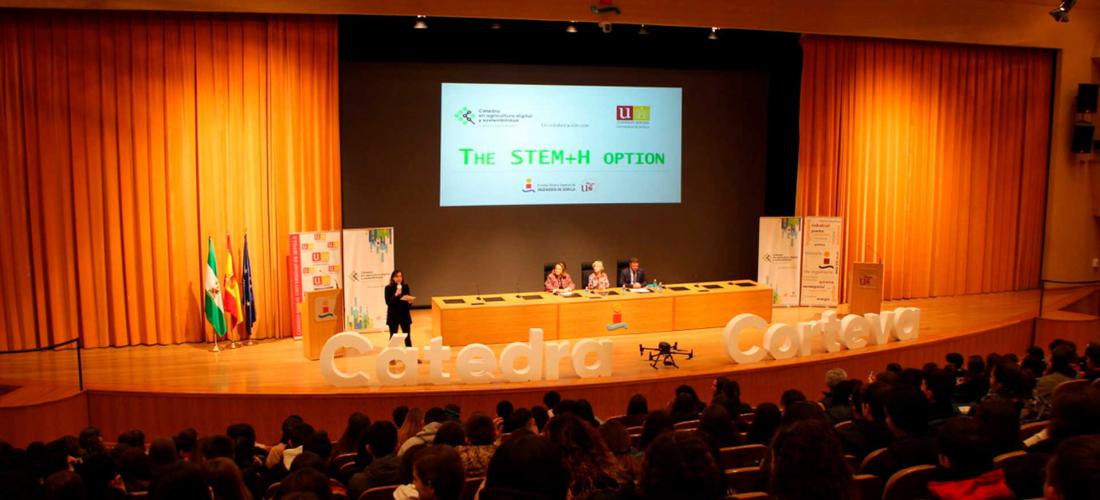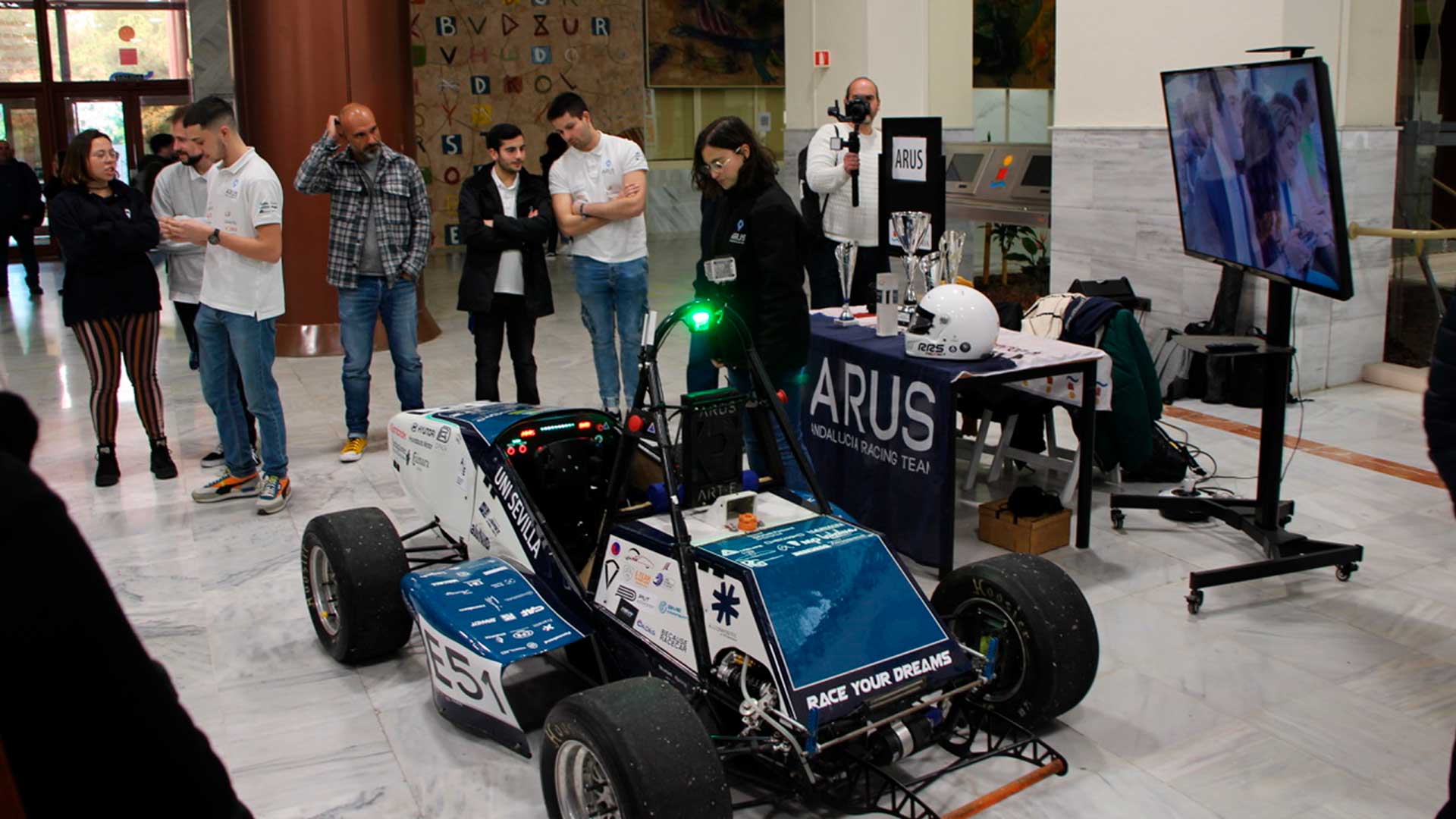The ETSi welcomes more than five hundred secondary school students to the event “The STEM+H option” organized by the Corteva Chair and the Social Council of the US
The ETSi hosts The STEM+H option, an event organized by the Corteva Chair and the Social Council of the US , to encourage the choice of STEM+H university education in more than five hundred secondary school boys and girls.
The Higher Technical School of Engineering (ETSi) of the University of Seville was the location chosen for The STEM+H option that took place on February 7. The event featured the participation of five leaders in physics, mathematics, computer science, agronomy and aviation, who offered an inclusive and inspiring vision of the most valuable applications of these disciplines, emphasizing their strengths and, above all, how they complement each other to generate results. excellent and provide key contributions to improve our world.
The event has also offered participants the possibility of interacting with drones, racing cars and motorcycles, robots, model airplanes and satellites. These are multidisciplinary programs, promoted by the US, in which students from all degrees participate and through which they compete in international competitions.
Concha Yoldi García , president of the Social Council , and Manuel Pérez Ruiz , director of the Corteva Chair , send us aligned messages: “We want the participating girls and boys to feel that they truly have the ability to improve the world. Both STEM and the Humanities are magnificent paths for this, you just have to maintain a curious mind to drink from both sources and integrate them into your development. The future demands multidisciplinary professionals with social commitment. “Today we come to sow the illusion of knowledge and everything you can achieve with it, so that you can explore your passions and pursue your dreams, whatever path you choose.”
The STEM+H option is an initiative of the Corteva Chair and the Social Council of the University of Seville
The Social Council of the University of Seville guarantees the participation of society in the university, integrating social and academic interests into its mission. For its part, the Corteva Chair is the result of the agreement between the US and the company Corteva Agriscience to promote corporate social responsibility activities. The efforts of the Social Council and the Corteva Chair converge to improve the employability of students, increase the transfer of knowledge from the university to society and support non-profit entities in order to promote sustainable economic and social development by alleviating social inequalities in all areas.
The event is a testament to that commitment, offering students a unique and engaging opportunity to learn more about the limitless possibilities of STEM and the humanities, showcasing the best of both worlds.
The speakers who collaborated in the event were:
- Eleonora Viezzer , professor of Physics at the University of Seville and recent Physics award from the Royal Spanish Society of Physics-BBVA Foundation and Princess of Girona Foundation.
- Jesús Soto Prieto , professor of Mathematics at Hispalense and National Dissemination Award “Science in Action” and Dissemination Award from the University of Seville.
- Pedro Escobar Rubio , computer scientist and winner of the Entrepreneurship Contest of the University of Seville.
- Carmen Sánchez Franco , agronomist, Master in Digital Agriculture and Agri-Food Innovation from the US and expert in geomatics and remote sensing with satellite images.
- Antonio Sousa Lamas , pilot of all types of aircraft and safety expert. He presides over the Spanish Association of Expertise in Intelligent Systems, and is a professor at various universities.
The organization thanks these people, as well as the ETSi for their facilities so that The STEM+H option could be carried out. To the same extent, thanks are due to the teams of students who have exhibited their work to allow the youngest to interact with the devices and demonstrate the need for contributions from different disciplines to complete a unique project.
The multidisciplinary teams that were presented in The STEM+H option are:
- ARUS is the team made up of more than 90 students who, during the academic year, design and assemble an electric single-seater with which to compete in the Formula Student.
- ESBot is a university association specialized in robotics that organizes courses, excursions and projects in various branches of engineering to provide a global vision of the world of technology.
- FYCUS is an international project of students who organize to design, assemble, test on the ground and then fly a CubeSat that fulfills one or more previously defined missions.
- USRacing is dedicated to creating an electric motorcycle from scratch that will compete against teams from all over the world in the Moto Student discipline.
- VANTUS is the US model airplane team. They design, build and fly radio-controlled aircraft with which to compete in different championships.
- GO Phytodron . Aerial equipment for the application of phytosanitary products in the agricultural sector.
The International Day of Women and Girls in Science has been celebrated worldwide since the United Nations General Assembly proclaimed it in 2015. From there, very different institutions carry out activities aimed at promoting scientific and technological vocations among girls and adolescents, making visible the work of scientists and technologists and generating female references in the STEM field, promoting practices that favor gender equality. in the scientific field, in order to eliminate gender stereotypes within the field of science and technology
STEM is the acronym for the English terms Science, Technology, Engineering and Mathematics. It refers to the areas of the economy that demand the most employment and that are expected to continue to demand in the future. In addition to technical knowledge, “soft skills” such as creativity, critical thinking, service orientation, collaboration, communication and problem-solving skills are required.
However, despite the increase in demand, thousands of jobs remain uncovered in Spain and throughout Europe due to the lack of qualified profiles and the decline in STEM . This decline is worse in the case of girls, whose representation remains below 20% of all students in many engineering and computer science degrees.
The lack of gender equality in these degrees can cause the wage and occupational gap between men and women to widen. To help reverse this trend, the Corteva Chair and the US Social Council proposed this innovative event in order to show the best of the humanities and STEM to new generations and motivate them to approach their future with an integrative and multidisciplinary.








